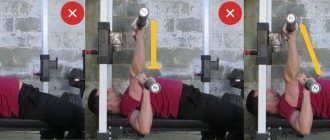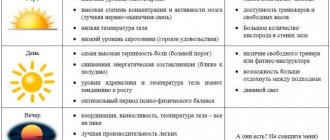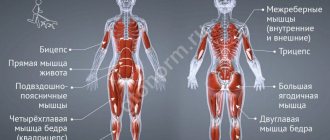What is aerobic training
Let's briefly analyze the biochemical processes of fat burning (how to deal with fat) and energy production. All the energy the body needs for life (movement, breathing, digestion of food, etc.) is generated by the breakdown of glucose. Glucose is in the blood, where it enters in various ways; the normal level is 3.3-5.5 mmol/l. When a glucose molecule is broken down, the so-called ATP, which is energy. It is sent through the bloodstream to an organ that needs energy, or is converted into heat. There are two ways to break down glucose:
- aerobic;
- anaerobic.
Aerobic is much more beneficial for the body: from one glucose molecule, as a result of the reaction with oxygen, as many as 38 ATP molecules are formed.
If the load on the body is so intense that glucose “does not have time” to be broken down in sufficient quantities in this way, the anaerobic pathway, or glycolysis, is activated. This process proceeds faster, but with it, only 2 ATP is formed from 1 glucose molecule, and a toxin, lactic acid, is released as a byproduct of the reaction. Glucose enters the blood in various ways. The main source is its absorption from the intestines (the carbohydrate foods we consume are broken down into simple sugar). If this is not enough to provide energy, blood glucose levels drop. The body responds to hypoglycemia by lipolysis: the contents of fat cells begin to break down into glucose molecules, the newly formed glucose enters the blood and ensures the body’s activity.
Those. correct aerobic training for burning fat that interests us should be carried out according to two principles:
- aerobic glucose oxidation;
- obtaining new glucose through lipolysis.
What is aerobics
All processes occurring in the body can be divided into aerobic and anaerobic; in the first case, oxygen is involved, in the second - not. Strength training takes place without the participation of oxygen; when performing exercises, muscle fibers are damaged, which are subsequently strengthened and restored. Aerobic exercise does not have such an effect on muscles; it promotes the oxidative process, which leads to calorie consumption and, as a result, weight loss.
It has been proven that more energy is spent when performing aerobic exercise than when performing anaerobic exercise, so the first type of exercise is most common among women. Moreover, such a set of exercises looks much more feminine than lifting a barbell. But it is worth remembering that to achieve maximum results, an integrated approach is still required, so strength training should not be completely excluded.
The choice of Arabica by many women is due to the following advantages:
- thanks to a large selection of aerobic programs, you can choose the one that will have the maximum effect and provide emotional pleasure;
- this type of training can be performed both in group classes and independently at home;
- does not require special conditions and the purchase of special devices;
- classes help develop grace, plasticity and coordination;
- has a beneficial effect on the cardiovascular system;
- promotes high calorie consumption.
But it is worth remembering that aerobic exercise is contraindicated for overweight people due to the risk of overloading the joints, which can already be loaded with obese weight. People with joint diseases should also exercise with caution. Before doing aerobics, it is advisable to first consult with your doctor.
General rules for aerobic exercise
Based on biochemical mechanisms, patterns can be derived for healthy, effective training:
- gradual increase in load from beginning to end
. If immediately after a 10-minute warm-up you give an intense load, the glucose that was already in the blood will quickly be used up, and lipolysis will not have time to activate. The result is nausea, dizziness, fainting - right in the middle of a workout.
— duration
. Daily 20-minute workouts can strengthen muscles and increase endurance, but they are practically useless for losing weight. Lipolysis is activated on average 20-30 minutes after the start of the exercise, so the optimal training duration is 50-90 minutes. Read about other reasons why playing sports does not help you lose weight in the article on the website.
— water
. Old school coaches still prohibit drinking water during training. But even if you don't sweat much, water evaporates intensely from the surface of the skin. And this water is taken from blood plasma! That is, when the water balance is not replenished, blood thickening occurs, which impedes the functioning of the heart, the movement of blood through the vessels and the delivery of oxygen to the brain and organs. A state of unpleasant health and the prospect of serious consequences. On the other hand, conservative trainers are also right: a sharp increase in blood volume due to drinking water is an even greater burden on the heart. Stick to a compromise: a few sips every 10 minutes. The body will be grateful!
— Fresh air
. You shouldn't run outside at -20. But where you exercise, there must be enough oxygen, you already know why.
— average load intensity
. As we have already found out, glycolysis is activated during heavy physical activity. Not only does the body begin to work “for wear,” but lactic acid is deposited in the muscles (since the anaerobic breakdown of glucose occurs directly in the working muscle). It is this toxic substance that causes terrible pain in the arms the morning after lifting weights, but this is not all of its harm. It is gradually removed from the muscles through the bloodstream, and with it it enters other organs, including the brain. There is no emergency danger in this, but regular such exposure does not improve brain function.
Cardio workout to burn fat in the gym
We are faced with the question of how to most effectively build a cardio workout in the gym.
We know that the stress of strength training stimulates the production of catecholamines: adrenaline and norepinephrine, which effectively trigger lipolysis (the breakdown of fat).
Therefore, we will use cardio training together with strength training:
- BEFORE STRENGTH TRAINING: 30-50 minutes of low-intensity cardio (burn free fatty acids in the muscles);
- 15-50 minutes STRENGTH (high-intensity anaerobic exercise to trigger lipolysis);
- 1-1.5 hours REST (wait for fatty acids to enter the muscles);
- 30-50 minutes of low-intensity cardio (burn free fatty acids in the muscles);
- 15-50 minutes STRENGTH (high-intensity anaerobic exercise to trigger lipolysis);
This scheme is designed for those people who have a lot of free time (for example, if you are a student or unemployed).
For all those less fortunate in terms of time, I suggest working according to the following scheme:
- In the morning: 30-50 minutes of low-intensity cardio (burn free fatty acids in the muscles). You can walk down the street on an empty stomach at a brisk pace;
- BEFORE STRENGTH TRAINING: 30-50 minutes of low-intensity cardio (burn free fatty acids in the muscles);
- 15-50 minutes STRENGTH (high-intensity anaerobic exercise to trigger lipolysis);
- We change clothes: 30-50 minutes of low-intensity cardio (burn free fatty acids in the muscles). You can walk down the street towards the house at a brisk pace;
Experiment! Think about how you can add more cardio into your schedule. I'm sure it can be done.
Attention! Remember that fat burning will be most effective when your blood sugar levels are low, so I suggest you use the KETO diet or the BUTCH diet. Or do this scheme in the morning on an empty stomach.
Attention! Strength training should be in the medium rep range (6-12 for men and 8-15 for women), and the last sets should be done in a pumping style for 20-30 reps (partial amplitude possible, UNTIL THE BURN). Lose weight and do high reps.
If you are just starting to train in the gym and don’t know which strength training to start with, then I suggest you download my free system for choosing an individual training program, which will help you choose a training program depending on your gender, age, fitness and genetics:
Why don't I tell you what kind of cardio you should do?
Because it doesn't really matter that much, especially if you're working out in a gym that's full of cardio-friendly equipment.
You can do:
- Walking fast on a treadmill.
- Riding an exercise bike.
- Ellipse (such a machine with pedals and handles, depicts walking with poles)
- Swimming in the pool.
Any aerobic low-intensity activity.
Heart rate and its control
Like I said, it doesn’t really matter which cardio machine you choose for your workouts, it’s important to PAY ATTENTION to your heart rate (heart rate).
As a rule, your heart rate should be in the range of 110-160 beats per minute.
At this heart rate range, your body will be highly oxygenated, making it more efficient at oxidizing fatty acids.
Monitoring your heart rate is very easy. Almost every exercise machine has special pads on the handles, by holding which you will immediately know your heart rate.
Or, if you have very ancient exercise equipment in your gym, then buy a heart rate monitor or a wristwatch that allows you to control this parameter.
Heart rate (HR) should be calculated individually, depending on your age, fitness level and other individual characteristics! It is very important!
If for a young trained person a heart rate of 160 beats per minute is the norm, then for a 50-60 year old woman such a heart rate will be disastrous.
The most accurate formula IN THE WORLD for calculating the MAXIMUM ALLOWABLE heart rate is this:
HRmax = 205.8 – (0.685 * age)
- HRmax is the maximum allowable heart rate for a given person.
- age – a person’s age in years.
For example, for me, a 27-year-old trained person, this formula gives a number approximately equal to 187 beats per minute.
Someone will ask: “Nikita, but this figure is not in the range that you said to focus on 110-160 blows?”
Yes it is.
- First: You must understand that this formula is derived EMPIRICALLY, i.e. based on EXPERIMENTAL DATA. It is not universal, although it is quite accurate.
- The formula determines the MAXIMUM ALLOWABLE number of heartbeats, i.e. that moment when your body works to the limit, which can be risky for older athletes (you can severely overload the heart). For example, for 50-year-old athletes the figure is 153 beats/min, which is clearly a lot for the AVERAGE value, but acceptable for the maximum. Feel free to reduce the resulting value by 15-20% and get a rational heart rate for you.
Types of aerobic training
We have already figured out that any physical activity that occurs due to the oxygen catabolism of glucose is aerobic.
Aerobic training is:
- simple;
- power;
- interval.
1. Simple aerobic exercise
is, for example, running, swimming, volleyball, tennis, brisk walking.
Effects
: strengthening the cardiovascular system, normalizing weight, increasing the body's endurance, increasing the vital capacity of the lungs and oxygen saturation of all organs and tissues.
2. Aerobic strength training
: running or aerobics with dumbbells/other weights, step aerobics (“weighting” is your own body weight), walking/running up stairs, exercise in the gym (yes, with a properly drawn up training plan, exercise on exercise machines, contrary to popular belief myth, is also an aerobic exercise).
Effect:
increasing endurance, strengthening muscles, building muscle mass.
Note to the reader!
Read in one of the articles on our website about the most effective strength training program for weight loss - the Hot Iron program.
3. Interval classes
are the hardest in terms of endurance, but they are the best aerobic workouts for weight loss. Each strength exercise is followed by 3-5 minutes of simple aerobic activity, then the next strength exercise is performed without delay. Interval training should only be done at an average to high level of fitness and no more than every eighth workout. That is, when training twice a week, interval training is carried out once a month.
Effect:
the sum of the effects of simple and resistance aerobic training squared.
Balance and Harmony
So what should we do? The answer is simple - physical activity should be harmonious and balanced .
The modern lifestyle of a person is such that aerobic activity is the last thing to go. Still, we go shopping, walk some distance along the street, clean the house ourselves, wash the dishes. Many people have a piece of land, and there is always work on it. But the power load disappears first.
We are not talking about flexibility and balance training here - they do not affect the structure of the body. They are needed for health.
Since childhood we have heard: “Put it on!” This is heavy! Carrying heavy objects is considered shameful. Working out with less heavy dumbbells is scary: “These are hands like a man’s!” Push-ups and pull-ups, “Thank God!” stayed at school... We quickly try to put our own child in a stroller or crib - “He’s heavy! Mom’s arms are falling off... her back hurts... whatever else...".
As a result, the muscles atrophy as unnecessary. That is, in fear of muscle hypertrophy or due to our own laziness, we lose even normal muscle mass . As a result, we gain weight due to adipose tissue, we get problems with posture and joints, and a whole bunch of other troubles.
This has gone so far that the WHO has developed minimum physical activity for adults. As stated at the beginning of the article, 75-150 minutes per week are devoted to aerobic exercise, depending on the intensity. Two hours - 120 minutes are allocated for strength training. And, 60 minutes each to train balance and flexibility.
It is strength training that will bring our muscles to a normal healthy state. In this state, they will consume much more energy and will help maintain normal body weight.
Muscle tissue in normal condition gives the body clear contours and beauty.
Another benefit of strength training is delayed calorie expenditure. After training, muscles spend additional energy on recovery. With aerobic training, you spend energy only while you are training, and with strength training - during training + at least another 24 hours!
Where to begin
It is not easy for a person who has never been involved in sports to do one-hour aerobic exercise several times a week.
There are two options for starting regular aerobic training: 1. gradually increasing the duration: start with a 10-minute run at a speed of 8 km/h and increase the time by a few minutes every 4 workouts, depending on how you feel;
2. gradually increase the load: start with an hour-long walk. When you feel that walking is easy for you, increase the pace without changing the duration of the exercise.
An interesting and effective type of training that combines the opportunity to strengthen muscles, gain an athletic figure and burn excess fat is fitness strength aerobics.
The essence of cardio training
Aerobic exercise is a powerful health booster. Regular aerobic exercise helps:
- Development and strengthening of the respiratory system
- Strengthening the myocardium. Increases the ability of the heart muscle to work when there is a lack of oxygen (heart attack prevention)
- Increases the number of red blood cells, which improves tissue nutrition
- Better blood supply to all tissues of the body
- Great mood - during training there is a powerful release of endorphins
- Reducing the risk of developing diabetes
The intensity of a cardio workout is measured using heart rate (HR). It is convenient to dose cardio over time.
The effect of training is manifested if a person performs it with sufficient intensity, duration and regularity. The World Health Organization recommends a minimum amount of 150 minutes of moderate-intensity aerobic exercise per week or 75 minutes of vigorous-intensity exercise. The minimum training duration is 10 minutes. Doubling your training volume will be beneficial.











